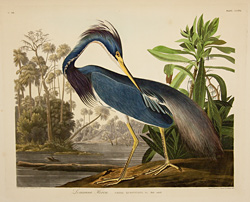 John James Audubon, "Louisiana Heron," Plate CCXVII from The Birds of America (London: Published by the Author, 1827–1838).
John James Audubon, "Louisiana Heron," Plate CCXVII from The Birds of America (London: Published by the Author, 1827–1838).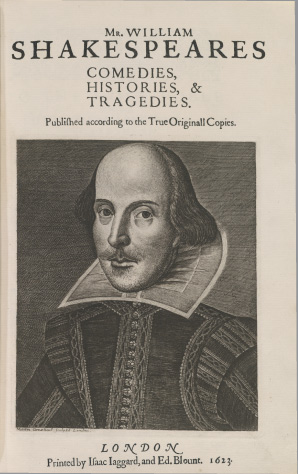 William Shakespeare, Comedies, Histories, & Tragedies (London: Isaac Jaggard and Ed. Blount, 1623).
William Shakespeare, Comedies, Histories, & Tragedies (London: Isaac Jaggard and Ed. Blount, 1623).The decade of the ’70s began and ended with a succession of magnificent gifts to Special Collections. On the occasion of his 50th reunion, in 1970, Albert E. Lownes presented Brown University with the double elephant folio edition of John J. Audubon’s Birds of America (London, 1827–1838). Receipt of this monumental work of 19th century ornithology constituted the first stage of a dramatic metamorphosis that would take place within the History of Science collection.
Less than six months later the library obtained one of the highlights of English literature, a First Folio edition of William Shakespeare’s Comedies, Histories & Tragedies (London, 1623), from Mr. and Mrs. William V. A. Hansen. This volume bore the bookplate of William Jaggard, a 19th century bibliographer and descendant of its printer, Isaac Jaggard. In 1972, the Hansens continued to enrich the collection with copies of the Second and Fourth Folios (London, 1632 and 1685) plus the Second Quarto edition of Julius Caesar (London, 1691).
With the removal of the circulating science collections to new quarters, Special Collections assumed exclusive responsibility for the administration of the John Hay Library at the beginning of 1972. This was a positive step as it gave Special Collections a position of greater prominence within the library system and beyond, but the physical structure bore the ravages of almost 75 years of hard duty. In order to adequately preserve and promote the riches contained within it, preliminary plans soon began to transform the structure into a state-of-the art facility, a process that would come to fruition a decade later.
The first important collection to arrive at the John Hay Library in the 1970s was that of S. Foster Damon, Curator of the Harris Collection for over 40 years and one of the world’s foremost authorities on the work of William Blake. Damon’s books and files were so vast and his interests so diverse that this legacy became four separate collections.
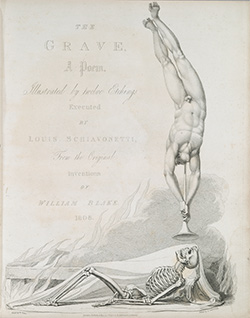 William Blake, The Grave (London: Printed by T. Bensley, for R. Ackerman, 1813).
William Blake, The Grave (London: Printed by T. Bensley, for R. Ackerman, 1813).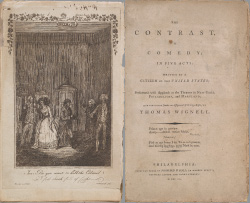 Royall Tyler, frontispiece and title page from The Contrast, A Comedy (Philadelphia: Prichard & Hall, 1790).
Royall Tyler, frontispiece and title page from The Contrast, A Comedy (Philadelphia: Prichard & Hall, 1790).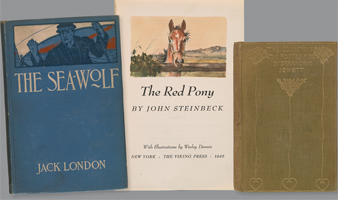 Left to right: Jack London, The Sea-Wolf (New York: The Macmillan Company, 1904);
Left to right: Jack London, The Sea-Wolf (New York: The Macmillan Company, 1904);The Damon Papers contain manuscripts and typescripts for articles, verse, plays, musical compositions, lectures, plus his private diaries and correspondence with prominent literary figures of the 20th century. The Damon Collection of Occult and Visionary Literature reflects a fascination with alchemy, mysticism, symbolism, and theosophy. These themes are echoed in the Damon Blake Collection of secondary sources and critical studies plus original and facsimile examples of Blake’s work, especially those from the Trianon Press. Finally, a series of American Tales of Imagination, featuring most of L. Frank Baum’s Oz stories, completes this quartet of collections from the Damon bequest. To these should be added a copy of Royall Tyler’s The Contrast (Philadelphia, 1790), the second play and first comedy written by an American, donated in Damon’s memory by friends and colleagues.
A collection of 248 Civil War prints, with more than 100 lithographs issued by Currier & Ives, was received from Dr. Walter S. Jones, Class of 1926, during 1972. These were soon joined by two bequests of W. Easton Louttit, Jr.: the Dard Hunter Collection of 75 books designed or printed by this famous American paper historian; and an assortment of volumes on the history of the Orkney Islands. It was during this period that Harold L. Tinker, Class of 1921, retired from teaching at Choate School and began a program of donating his library of 19th and 20th century American prose writers to Brown. This gift, numbering over 3,000 volumes, is particularly rich in works by women authors including, among others, Mary H. Catherwood, Sarah Orne Jewett, Laura E. Richards and Harriet Beecher Stowe. Tinker, who numbered John F. Kennedy among his students, later presented the library with 16 letters as well as autographed copies of all the books he received from the President between 1945 and 1963.
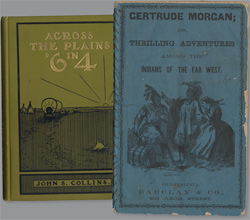 Left: John S. Collins, Across the Plains in '64 (Omaha: National Printing Company, 1904).
Left: John S. Collins, Across the Plains in '64 (Omaha: National Printing Company, 1904).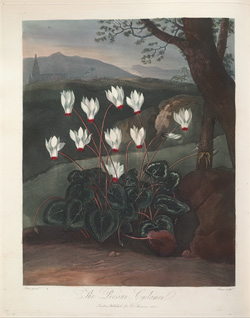 Robert John Thornton, The Temple of Flora (London: T Bensley, 1799-1807).
Robert John Thornton, The Temple of Flora (London: T Bensley, 1799-1807).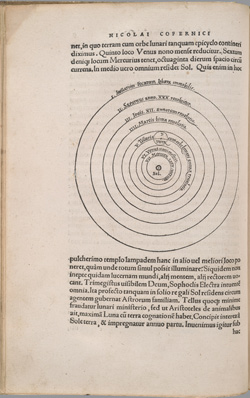 Nicolaus Copernicus, De Revolutionibus Orbium Coelestium Libri VI (Nuremberg: Johannes Petreius, 1543).
Nicolaus Copernicus, De Revolutionibus Orbium Coelestium Libri VI (Nuremberg: Johannes Petreius, 1543).David A. Jonah retired as Director of Libraries in 1974 after 39 years of service to Brown. He was succeeded by Charles D. Churchwell (1974–1978) and C. James Schmidt (1979–1981). Among the first collections received during this period was the Eberstadt Collection of Western Pioneer Narratives, which arrived in 1977 as a memorial to Charles F. Eberstadt, Class of 1934, one of the nation’s leading booksellers. The Eberstadt Collection was the library’s first discrete collection focusing exclusively on the American West. Among its 300 volumes are crudely printed journals written by emigrants as they crossed the plains to California during the Gold Rush of 1849 as well as Western classics published in fine editions by John Henry Nash and the Grabhorn Press.
In January of 1979, the remainder of Albert E. Lownes's Collection of Significant Books in the History of Science arrived by bequest. His final gift of over 5,000 volumes plus hundreds of prints and manuscripts spanned the centuries of scientific thought from Ptolemy to Einstein. This was one of the three most important private collections of books of science in America and ranks as one of the most significant single collections ever received by the Brown University Library. Its greatest strength and depth is in natural history although its scope embraces significant works in all scientific fields. Lownes defined significance as being “books that have changed the world or man’s way of seeing it. Significance also meant books that I found interesting.” As a result, the collection contains the first appearance in print of virtually every major scientific discovery from the classical age to the 20th century, as well as significant later editions and complementary works that give the collection added depth. Through gift and purchase, the Lownes Collection has grown even stronger over the past 30 years, especially through the donation of the Rhode Island Medical Society Library and a series of gifts from Daniel G. Siegel, Class of 1957, and George A. Bray, Class of 1953.